
Vilnius University Library
Encyclopedia
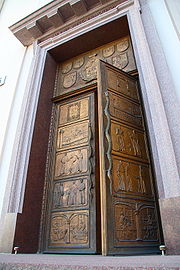
Lithuania
Lithuania , officially the Republic of Lithuania is a country in Northern Europe, the biggest of the three Baltic states. It is situated along the southeastern shore of the Baltic Sea, whereby to the west lie Sweden and Denmark...
. It was founded in 1570 by the Jesuits and as such is nine years older than Vilnius University
Vilnius University
Vilnius University is the oldest university in the Baltic states and one of the oldest in Eastern Europe. It is also the largest university in Lithuania....
. VU Library holds 5.4 million documents on shelves measuring 166 kilometres (103.1 mi) in length. The holdings, accessible to members of the university and wider public, include some of the oldest manuscripts, incunabula and engravings in Lithuania and Eastern Europe. As of 2010, the library has 28,420 users.
VU Central Library is located in the Old Town of Vilnius near the Presidential Palace of Lithuania. The central library has 20 branch libraries that serve the needs of faculties and centers of Vilnius University. The central library has a lending room, 13 reading rooms, 3 halls for group work. Some of the rooms are located in historical halls with great artistic and architectural value. The architectural ensemble of Vilnius University attracts more than 10,000 tourists from Lithuania and other countries annually.
Jesuit Order
Invited by Bishop of Vilnius Walerian ProtasewiczWalerian Protasewicz
Walerian Protasewicz was bishop of Lutsk and Vilnius . To combat Reformation he invited Jesuits to the Grand Duchy of Lithuania. He funded the Jesuit college in Vilnius and obtained Papal and Royal privileges to convert the college into Vilnius University in 1579...
, the Jesuits came to Vilnius in 1569. On July 17, 1570 they established a college and a library. The core of the library consisted of the collections of the Grand Duke of Lithuania and King of Poland Sigismund Augustus and suffragan bishop
Suffragan bishop
A suffragan bishop is a bishop subordinate to a metropolitan bishop or diocesan bishop. He or she may be assigned to an area which does not have a cathedral of its own.-Anglican Communion:...
of Vilnius Georg Albinius. The library of Sigismund Augustus contained the best of classical works, travelogues, historical books, chronicles, and literature on natural science, law, military, and medicine published in the 16th century. It included the Bible translated by Martin Luther
Martin Luther
Martin Luther was a German priest, professor of theology and iconic figure of the Protestant Reformation. He strongly disputed the claim that freedom from God's punishment for sin could be purchased with money. He confronted indulgence salesman Johann Tetzel with his Ninety-Five Theses in 1517...
, works by Euclid
Euclid
Euclid , fl. 300 BC, also known as Euclid of Alexandria, was a Greek mathematician, often referred to as the "Father of Geometry". He was active in Alexandria during the reign of Ptolemy I...
and Claudius Ptolemaeus, the first edition of De revolutionibus orbium coelestium by Nicolaus Copernicus
Nicolaus Copernicus
Nicolaus Copernicus was a Renaissance astronomer and the first person to formulate a comprehensive heliocentric cosmology which displaced the Earth from the center of the universe....
, and many other works.
Privileges issued by King Stephen Báthory on April 1, 1579 converted the Vilnius Jesuit College into a university, and the library into a university library. In 1580 Bishop Protasewicz bequeathed several thousand books to the library upon his death. Many of Lithuania's clergy and the nobility also donated books to the library.
During the 200 years of Jesuit rule at the university, the library collection grew from 4,500 volumes (in 1570) to 11,000 volumes (in 1773). A series of wars, fires and plunders prevented the library from growing further and a great many of its books ended up in libraries in Russia, Poland, Sweden and elsewhere.
After the Jesuit Order was abolished in 1773, the Commission of National Education took on custody of the Vilnius University. In 1781 the University was renamed Head School of Lithuania. Its academic course altered, and the library fund was replenished with books on natural science and medicine.
Russian Empire
After the Third Partition of the Polish–Lithuanian CommonwealthThird Partition of Poland
The Third Partition of Poland or Third Partition of the Polish-Lithuanian Commonwealth took place in 1795 as the third and last of three partitions that ended the existence of the Polish-Lithuanian Commonwealth.-Background:...
in 1795, the greater portion of the Grand Duchy of Lithuania
Grand Duchy of Lithuania
The Grand Duchy of Lithuania was a European state from the 12th /13th century until 1569 and then as a constituent part of Polish-Lithuanian Commonwealth until 1791 when Constitution of May 3, 1791 abolished it in favor of unitary state. It was founded by the Lithuanians, one of the polytheistic...
, including its capital Vilnius, became part of the Russian Empire
Russian Empire
The Russian Empire was a state that existed from 1721 until the Russian Revolution of 1917. It was the successor to the Tsardom of Russia and the predecessor of the Soviet Union...
. In 1803 the Head School of Lithuania was renamed the Vilnius Imperial University. By 1820s, Vilnius University ranked among the leading universities in the Russian Empire; the revival of academic research had a positive effect on the library as well. In 1804 professor Gottfried Ernest Groddeck was appointed the head of the library. He succeeded in making it accessible to the public. A Lending Department was opened in 1815, and university staff and students, officials of the educational districts, and gymnasium teachers were allowed to borrow books. The library was moved to the Small Aula, which had a ninety-seat reading room. Groddeck initiated the compilation of an alphabetic and later a systemic card catalog. Compared with other libraries in the Russian Empire, the Vilnius University Library had attained the most advanced European standards at that time.
After the November Uprising
November Uprising
The November Uprising , Polish–Russian War 1830–31 also known as the Cadet Revolution, was an armed rebellion in the heartland of partitioned Poland against the Russian Empire. The uprising began on 29 November 1830 in Warsaw when the young Polish officers from the local Army of the Congress...
, Tsar Nicolas I
Nicholas I of Russia
Nicholas I , was the Emperor of Russia from 1825 until 1855, known as one of the most reactionary of the Russian monarchs. On the eve of his death, the Russian Empire reached its historical zenith spanning over 20 million square kilometers...
closed the university on May 1, 1832. A large part of library's collection was taken from Vilnius and distributed to various academic institutions in Russia. There were unsuccessful attempts 1834 to establish a public library with the remaining books from the university library. In 1856 the Antiquities Museum and a reading room began to function under the auspices of the Archaeological Commission. In 1865 they were converted into the Vilnius Public Library and Museum. The library was given nearly 200,000 volumes of valuable books and manuscripts from the collections of schools, cloisters, and private libraries that had been closed after uprisings in 1831 and 1863. By 1914 the Vilnius Public Library contained more than 300,000 books and ranked 4th among the libraries in the Russian Empire. It was devastated during World War I, and books were once again transported to Russia.
After World War I
Vilnius University was reopened by Poles on October 11, 1919, and renamed in honor of Stephen Báthory. Though it had been plundered, the library retained a fairly large collection. During World War II, the library suffered again from plunder and fire. The destroyed university and its library needed rapid restoration after the war. Reading rooms were installed and bibliographical activities soon organized. The library managed to retrieve approximately 13,000 of its valuable publications.The Vilnius University Library witnessed the following significant events during the period of 1945–1990: the 400th anniversary of the library and the university (in 1970 and 1979 accordingly), the building of two new book depositories, and founding of new departments. The early book collections needed restoration, and Jurgis Tornau, then director of the library, undertook to establish the Department of Restoration in 1968. The library acquired the Department of Graphic Arts in 1969. At the end of the 1960s a decision was made to safeguard integral collections from various donors in the main library depository.
After regaining Lithuania independence
The library has been equipped with a computerized catalog since 1993, accessible via the Internet since 1994. In 1999, the library began a digital project to preserve its unique holdings – digitization of old books and manuscripts of the 16th–19th centuries (land and castle court books of various districts in the Grand Duchy of Lithuania) and release them on CDs. In 2000 VU Library together with other Lithuanian libraries started to subscribe to various databases, and EBSCO, a universal database of full-text documents, came first. In 2005 for the first time in Lithuania academic libraries history, the information centre "Odysseus" for people with disabilities was opened.A competition for a memorial site at the Vilnius University Library, which had been announced on the occasion of the 450th anniversary of the first Lithuanian book, was won by artist Jonas Meškelevičius (1950–2005), who submitted a project for a commemorative doorway to the library. The official unveiling
of the memorial – double doors immortalizing images of major events in the history of Lithuanian culture and of the university – took place on May 21, 2001.
Leaders of the library
VU Library leaders:- Jonas Hėjus (till 1575)
- Laurynas Rydzevskis (1756–1757)
- Stanislovas Rostovskis (1765–1765)
- Juozas Pažovskis (1778–1787)
- Tadeušas Mackievičius (1787–1792)
- Rapolas Litvinskis (1792–1799)
- Augustinas Tomaševskis (1805) – adjunct
- Fransua de la Žumeljė (1807) – adjunct
- Gotfrydas Ernestas Grodekas (1804–1825)
- Liudvikas Sobolevskis (1826–1830)
- Pavelas Kukolnikas (1830–1832)
- Aleksejus Vladimirovas (1866–1869)
- Jakovas Golovackis (1871–1888)
- Julijanas Kračkovskis (1888–1902)
- Flavianas Dobrianskis (1902–1913)
- Dmitrijus Daugėla (1913–1915)
- Eduardas Volteris (1919)
- Steponas Henrikas Rygielis (1924–1929)
- Adomas Gracijonas Lysakovskis (1930–1939)
- Vaclovas BiržiškaVaclovas BiržiškaVaclovas Biržiška was a Lithuanian attorney, bibliographer, and educator.He was a member of a notable Lithuanian family; his great-grandfather Mykolas Biržiška was a representative in the Sejm when the Constitution of 3 May was accepted in 1791; his grandfather Leonardas Biržiška was an active...
(1940–1941) - Elena Eimaitytė-Kačinskienė (1941, 1943 – leader at interim)
- Juozas Baldžius (1944–1946)
- Marija Burokienė (1946–1948 – leader at interim)
- Levas Vladimirovas (1948–1964)
- Stasė Vaidinauskaitė-Vaškelienė (1964–1968)
- Jurgis Tornau (1968–1985)
- Birutė Butkevičienė (1985–2006; from September 2006 till September 2008 – director for Science and Cultural Heritage)
- Prof. Audronė Glosienė (General Director from September 2006 till January 2009)
- Irena Krivienė (Director for Economics and Development from September 2006 till March 2009. From March 2009 - Director General)
- dr. Marija Prokopčik (Director of Information and Cultural Heritage Activities from September 2008)
- Jūratė Kuprienė (Director for Economics and Development from January 2010)
Organization and structure
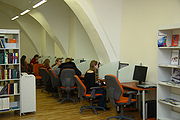
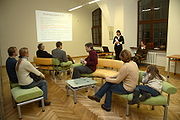
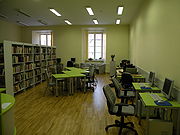
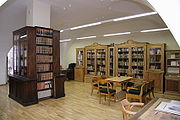
- Sidabrinė (Silver) (reading room). Modern publications on humanities, books and journals on principal humanitarian and interdisciplinary studies are arranged in open stacks. Mediatecque.
- Apelsininė (Orange) (a room for group work). For reservation.
- Riešutinė (Nut-brown) (information technologies laboratory). For reservation.
- Žalioji (Emerald green) (periodical reading room). Journals on politics, culture and art published in Lithuania and abroad are arranged in open stacks.
The Lithuanian Reading Room was opened in 2008 after reconstructing premises of the Vilnius University Library. There are two rooms – the Lithuanian Reading Room and Cabinet of Jurgis Lebedys. The Lithuanian Reading Room collects Lithuanian periodic from 1918 till 1939, research documents about Lithuanian history, geography, culture and art, etc. The Cabinet of Lebedys houses material for the studies of Lithuanian language and literature. The cabinet can be reserved for lectures or seminars.
The Rare Book Department has accumulated over 180,000 items from the 15th–21st centuries. It is the largest depository of old books in Lithuania and rivals the most famous libraries of Eastern Europe by its significance. The collection contains: the largest collections of incunabula and post-incunabula in Lithuania; 16th–18th century books; the richest in the world collection of old Lithuanian books (including the first Lithuanian book by Martynas Mažvydas
Martynas Mažvydas
Martynas Mažvydas Martynas Mažvydas Martynas Mažvydas (1510 near Žemaičių Naumiestis (now in Šilutė district municipality) - May 21, 1563 in Königsberg (now Kaliningrad) was the author and the editor of the first printed book in the Lithuanian language....
, Mikalojus Daukša
Mikalojus Daukša
Mikalojus Daukša was a Lithuanian and Latin religious writer, translator and a Catholic church official...
's Katekizmas, works by Baltramiejus Vilentas); especially valuable old atlases and maps; book collection of the Old Vilnius University Library – Bibliotheca Academiae Vilnensis (it includes books from collections of Sigismund August, Sapieha family, Georg Albinius, Walerian Protasewicz
Walerian Protasewicz
Walerian Protasewicz was bishop of Lutsk and Vilnius . To combat Reformation he invited Jesuits to the Grand Duchy of Lithuania. He funded the Jesuit college in Vilnius and obtained Papal and Royal privileges to convert the college into Vilnius University in 1579...
, M. Pacas, E. Valavičius and university professors).
The Manuscript Department contains more than 265,000 documents, divided into 301 archival collections of smaller or larger scope: Vilnius University, Vytautas the Great University in Kaunas, editorial boards, societies and institutions, church institutions, collections compiled by the department and personal collections. The earliest document – a land donation – is dated 1209. Documents were written in Lithuanian, Latin, Polish, Chancery Slavonic, Russian, German, English, Hebrew, Yiddish, Swedish and other languages. Documents are important for research of Vilnius University, development of different fields of science, university's relations with other higher schools of Central and Eastern Europe, history of science and culture of the Lithuanian state and neighboring countries.
The Graphic Arts Cabinet compiles various graphic works since the beginning of the 19th century when in 1805 the Department of Engraving and the Study of Graphics were established at the university. Major part of the collection comprises old graphics (about 12,000 items) dating back to 16th–19th centuries – artworks of Lithuanian, Russian, Polish artists and other painters from European countries. As of 2009, the Department of Graphic Arts holds over 91,000 artworks.
The Museum of Sciences, founded in 1973, compiles, processes and actualizes visual scientific material about historical Vilnius University. The Museum is housed in the premises of St. John's Church. Especially valuable is the collection of coins of the Grand Duchy of Lithuania, including 12th–15th century silver alloys – the so-called Lithuanian ilgieji (Lithuanian Long Bars) from Ribiškė hoard, roubles of Veliky Novgorod
Veliky Novgorod
Veliky Novgorod is one of Russia's most historic cities and the administrative center of Novgorod Oblast. It is situated on the M10 federal highway connecting Moscow and St. Petersburg. The city lies along the Volkhov River just below its outflow from Lake Ilmen...
, grivnas of Kievan Rus'
Kievan Rus'
Kievan Rus was a medieval polity in Eastern Europe, from the late 9th to the mid 13th century, when it disintegrated under the pressure of the Mongol invasion of 1237–1240....
. Museum's holdings also include large collections of Polish, Russian old coins.
The Museum of Adam Mickiewicz compiles, systematizes, stores, and investigates material related to Adam Mickiewicz
Adam Mickiewicz
Adam Bernard Mickiewicz ) was a Polish poet, publisher and political writer of the Romantic period. One of the primary representatives of the Polish Romanticism era, a national poet of Poland, he is seen as one of Poland's Three Bards and the greatest poet in all of Polish literature...
, his creative work and activities. Most valuable museum's exhibits are personal possessions of the poet: a small table, a chair and an arm-chair used by the poet when he lived in Kaunas and Paris. At present the museum displays more than 200 exhibits and has a small library.
The Philosophy Reading Room was opened in 2010 after reconstructing premises of the Vilnius University Library. The Philosophy Reading Room moved from the Faculty of Philosophy. It was the start of the integration of faculty libraries into the main buildings of Vilnius University library. The Philosophy Reading Room consists of 4 rooms, equipped with 40 individual and 11 computerized workstations. In open stacks - Educology, Philosophy, Psychology, Sociology, Social work and Medicine studies literature.
The Newspapers Reading Room was opened in 2010 after the reconstruction of main building. The Newspapers reading room is in the second floor next to the Philosophy reading room at the end of the corridor. You may find the latest authorized newspapers. There are plenty historical newspapers such as: „7 meno dienos“, „Atgimimas“, „Dialogas“, „Dienovidis“, „Lietuvos rytas“, „Lietuvos žinios“, „Literatūra ir menas“, „Mokslo Lietuva“, „Šiaurės Atėnai“, „Tremtinys“, „Voruta“, „XXI amžius“.
Oriental reading room was opened in 2011. The Oriental reading room is established in the Library premises, that have not been used up to now. They are architecturally rather complicated however also most interesting and highest-situated part of the Library. This reading room is the most silence place in the library. The Oriental reading room collection includes Research and studies in Asian languages, cultures, religions, philosophy, anthropology and art history releases, publications in original languages, fiction in foreign languages, Alfred Binder oriental collection.
Hall of Pranciškus Smuglevičius
The Hall of Pranciškus Smuglevičius is the oldest part of the original library complex, named after Franciszek SmuglewiczFranciszek Smuglewicz
Franciszek Smuglewicz or Pranciškus Smuglevičius, October 6, 1745 – September 18, 1807) was a Polish-Lithuanian draughtsman and painter. Smuglewicz is considered a progenitor of Lithuanian art in the modern era. Some consider him as a spiritual father of Jan Matejko's school of painting....
(1745–1807), celebrated painter and professor of the university. Until the end of the 18th century, the hall was used as a refectory
Refectory
A refectory is a dining room, especially in monasteries, boarding schools and academic institutions. One of the places the term is most often used today is in graduate seminaries...
. In 1803 it was assigned to the library and artist Smuglewicz was hired to decorate it. The painter adhered to the spirit of Classicism
Classicism
Classicism, in the arts, refers generally to a high regard for classical antiquity, as setting standards for taste which the classicists seek to emulate. The art of classicism typically seeks to be formal and restrained: of the Discobolus Sir Kenneth Clark observed, "if we object to his restraint...
; between the windows and on the walls he painted the portraits of the 12 most prominent figures in antique art and science: Socrates
Socrates
Socrates was a classical Greek Athenian philosopher. Credited as one of the founders of Western philosophy, he is an enigmatic figure known chiefly through the accounts of later classical writers, especially the writings of his students Plato and Xenophon, and the plays of his contemporary ...
, Plutarch
Plutarch
Plutarch then named, on his becoming a Roman citizen, Lucius Mestrius Plutarchus , c. 46 – 120 AD, was a Greek historian, biographer, essayist, and Middle Platonist known primarily for his Parallel Lives and Moralia...
, Pindar
Pindar
Pindar , was an Ancient Greek lyric poet. Of the canonical nine lyric poets of ancient Greece, his work is the best preserved. Quintilian described him as "by far the greatest of the nine lyric poets, in virtue of his inspired magnificence, the beauty of his thoughts and figures, the rich...
, Anacreon
Anacreon
Anacreon was a Greek lyric poet, notable for his drinking songs and hymns. Later Greeks included him in the canonical list of nine lyric poets.- Life :...
, Hesiod
Hesiod
Hesiod was a Greek oral poet generally thought by scholars to have been active between 750 and 650 BC, around the same time as Homer. His is the first European poetry in which the poet regards himself as a topic, an individual with a distinctive role to play. Ancient authors credited him and...
, Heraclitus
Heraclitus
Heraclitus of Ephesus was a pre-Socratic Greek philosopher, a native of the Greek city Ephesus, Ionia, on the coast of Asia Minor. He was of distinguished parentage. Little is known about his early life and education, but he regarded himself as self-taught and a pioneer of wisdom...
, Aristotle
Aristotle
Aristotle was a Greek philosopher and polymath, a student of Plato and teacher of Alexander the Great. His writings cover many subjects, including physics, metaphysics, poetry, theater, music, logic, rhetoric, linguistics, politics, government, ethics, biology, and zoology...
, Euripides
Euripides
Euripides was one of the three great tragedians of classical Athens, the other two being Aeschylus and Sophocles. Some ancient scholars attributed ninety-five plays to him but according to the Suda it was ninety-two at most...
, Diogenes
Diogenes
Diogenes is a Greek name shared by several important historical figures:*Diogenes of Sinope , better known as Diogenes the Cynic or simply Diogenes, philosopher...
, Homer
Homer
In the Western classical tradition Homer , is the author of the Iliad and the Odyssey, and is revered as the greatest ancient Greek epic poet. These epics lie at the beginning of the Western canon of literature, and have had an enormous influence on the history of literature.When he lived is...
, Archimedes
Archimedes
Archimedes of Syracuse was a Greek mathematician, physicist, engineer, inventor, and astronomer. Although few details of his life are known, he is regarded as one of the leading scientists in classical antiquity. Among his advances in physics are the foundations of hydrostatics, statics and an...
and Plato
Plato
Plato , was a Classical Greek philosopher, mathematician, student of Socrates, writer of philosophical dialogues, and founder of the Academy in Athens, the first institution of higher learning in the Western world. Along with his mentor, Socrates, and his student, Aristotle, Plato helped to lay the...
. From then on the hall was used for various ceremonies and celebrations. Adam Mickiewicz
Adam Mickiewicz
Adam Bernard Mickiewicz ) was a Polish poet, publisher and political writer of the Romantic period. One of the primary representatives of the Polish Romanticism era, a national poet of Poland, he is seen as one of Poland's Three Bards and the greatest poet in all of Polish literature...
was granted his diploma here in 1819. Prominent guests including Napoleon, Tsar Alexander II
Alexander II of Russia
Alexander II , also known as Alexander the Liberator was the Emperor of the Russian Empire from 3 March 1855 until his assassination in 1881...
, and others have visited this hall.
In 1855 the hall was assigned to the Antiquities Museum of the Vilnius Provisional Archaeology Commission and, when the commission was closed in 1865, to the Public Library of Vilnius. Over time hall's functions changed and in 1867 painter Vasilii Griaznov replaced its classical tones with pseudo-Byzantine
Byzantine art
Byzantine art is the term commonly used to describe the artistic products of the Byzantine Empire from about the 5th century until the Fall of Constantinople in 1453....
ornamentation. The hall was refurbished in 1929 and restored to the version by Smuglewicz. During the works, a 16th–17th century fresco of Mary enveloping the founders of the old university was uncovered on the ceiling. Since then the Hall of Smuglevičius has retained its appearance with furniture from the time of the Public Library of Vilnius. At present the hall is used by the Department of Rare Publications.
Hall of Joachim Lelewel
At first the hall was an almost square chapel with a vaulted ceiling, rising upwards through the second and third floors. The centre of the vaults was taken up by a panel with a painted portrait of St. Stanislaus KostkaStanislaus Kostka
Stanisław Kostka S.J. was a Polish novice of the Society of Jesus. In the Catholic Church as Saint Stanislaus Kostka....
, the guardian of students. The chapel was built in the middle of the 18th century according to designs of Tomas Žebrauskas. After the dissolution of the Jesuit Order the hall was used by the Department of Paintings. The hall was divided into two floors during the first quarter of the 19th century. For a long time the third floor was home to the Art Department, and the workplace of famous artist Jan Rustem
Jan Rustem
Jan Rustem was a painter of Armenian, Turkish or Greek ethnicity who lived and worked in the territories of the Polish–Lithuanian Commonwealth. Primarily a portrait painter, he was commissioned to execute portraits of notable personalities of his epoch...
. In 1929, professor Joachim Lelewel
Joachim Lelewel
Joachim Lelewel was a Polish historian and politician, from a Polonized branch of a Prussian family.His grandparents were Heinrich Löllhöffel von Löwensprung and Constance Jauch , who later polonized her name to Lelewel.-Life:Born in Warsaw, Lelewel was educated at the Imperial University of...
bequeathed a valuable collection of books and atlases to the library; they were transferred from Kurniki to this hall, which was then named in his honour and commemorative exhibition was arranged.
White Hall (old observatory)
The history of the White Hall is part of the history of the old observatory (founded in 1753) of the Vilnius University. The observatory was designed and built by Lithuanian architect and astronomer, VU professor, Tomas Žebrauskas. Funds for the building were donated by Ignacy Ogiński and his daughter Elżbieta Ogińska-Puzynina, whose particularly generous contribution of 200,000 Polish złoty gained her the title of the observatory patron.The observatory was composed of the White Hall, the Small Hall, two slender three-storey square towers, and two small single-storey towers. Six massive Baroque
Baroque architecture
Baroque architecture is a term used to describe the building style of the Baroque era, begun in late sixteenth century Italy, that took the Roman vocabulary of Renaissance architecture and used it in a new rhetorical and theatrical fashion, often to express the triumph of the Catholic Church and...
pillars, girded with ornamental cornice
Cornice
Cornice molding is generally any horizontal decorative molding that crowns any building or furniture element: the cornice over a door or window, for instance, or the cornice around the edge of a pedestal. A simple cornice may be formed just with a crown molding.The function of the projecting...
s divide the White Hall into three parts. An oval opening in ceiling appears to connect the White Hall with the Small Hall above it, and thereby conveys the Baroque concept of infinite space. A remarkable portrait of King Stanisław August Poniatowski is positioned in the centre of the tympanum
Tympanum (architecture)
In architecture, a tympanum is the semi-circular or triangular decorative wall surface over an entrance, bounded by a lintel and arch. It often contains sculpture or other imagery or ornaments. Most architectural styles include this element....
. The portrait is surmounted by allegorical figures of the sitting women representing Diana
Diana (mythology)
In Roman mythology, Diana was the goddess of the hunt and moon and birthing, being associated with wild animals and woodland, and having the power to talk to and control animals. She was equated with the Greek goddess Artemis, though she had an independent origin in Italy...
and Urania
Urania
Urania was, in Greek mythology, the muse of astronomy. Some accounts list her as the mother of the musician Linus. She is usually depicted with a globe in her left hand. She is able to foretell the future by the arrangement of the stars...
. Diana holds a portrait of benefactress Elżbieta Ogińska-Puzynina, while Uriana has a wreath of stars in her hands.
At the end of the 18th century, Marcin Odlanicki Poczobutt built an extension to the observatory, designed by architect Marcin Knackfus
Marcin Knackfus
Marcin Knackfus was a Polish–Lithuanian Neoclassical architect of German descent. Born near Warsaw, he worked in the Grand Duchy of Lithuania and particularly in its capital Vilnius...
in the Classical style
Classical architecture
Classical architecture is a mode of architecture employing vocabulary derived in part from the Greek and Roman architecture of classical antiquity, enriched by classicizing architectural practice in Europe since the Renaissance...
. The extension housed a large quadrant
Quadrant (instrument)
A quadrant is an instrument that is used to measure angles up to 90°. It was originally proposed by Ptolemy as a better kind of astrolabe. Several different variations of the instrument were later produced by medieval Muslim astronomers.-Types of quadrants:...
and other instruments. The White Hall contained not only astronomical equipment but also a valuable library with works on astronomy, mathematics, physics, geography, architecture, and other subjects taught at the university. The books were kept in 12 cupboards in niches between the windows. The hall was decorated with approximately 30 oil paintings of prominent individuals and university scholars. The observatory was seriously damaged by fire in 1876 and closed in 1883. During the time of the Public Library of Vilnius, the White Hall was used as a book depository. It was reopened in 1997 after 10-year renovation. A unique collection of ancient astronomical instruments, including globes made in Amsterdam in 1622 as well as globes made in 1750 and dedicated to King Stanisław August Poniatowski, is displayed in the White Hall. Now it houses the Professor's Reading Room and plans are made to arrange a museum of the university's history.
Philology Reading Room
The Philology Room occupies the second floor above the Hall of Smuglevičius. At first the room was the assembly hall of the Jesuit Academy, later it was converted into a library. When the library was transferred to the present Small Aula in 1819, the room housed a museum of mineralogyMineralogy
Mineralogy is the study of chemistry, crystal structure, and physical properties of minerals. Specific studies within mineralogy include the processes of mineral origin and formation, classification of minerals, their geographical distribution, as well as their utilization.-History:Early writing...
. After the university was closed, the hall belonged to the Museum of Antiquities from 1855 to 1865. In 1945, the hall was converted into the General Reading Room for the Vilnius University Library. The hall has once again been newly restored, according to a project by architect Aldona Švabauskienė. The parquet floor was restored according to thesurviving samples from the mid-19th century. The 17th century vaults have been preserved, but their decorations of plaster-work were painted over at the beginning of the 20th century, and now the room is devoid of embellishments.In the end of 2010 the hall was converted into the Philology Reading Room.
Professors' Reading Room
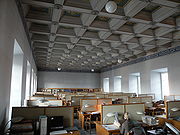
Frieze
thumb|267px|Frieze of the [[Tower of the Winds]], AthensIn architecture the frieze is the wide central section part of an entablature and may be plain in the Ionic or Doric order, or decorated with bas-reliefs. Even when neither columns nor pilasters are expressed, on an astylar wall it lies upon...
with floral ornaments was discovered under a layer of plaster during a restoration in 1919. The design of its wooden coffer
Coffer
A coffer in architecture, is a sunken panel in the shape of a square, rectangle, or octagon in a ceiling, soffit or vault...
ed ceiling by architect Karol Podczaszyński
Karol Podczaszynski
Karol Podczaszyński was a Polish-Lithuanian architect, a representative of the neoclassical architecture and a professor of the Imperial University of Vilna, as well as one of the pioneers of industrial design....
was discovered after a fire in 1969. It was renovated by Ferdynand Ruszczyc
Ferdynand Ruszczyc
Ferdynand Ruszczyc was a Polish painter, printmaker, and stage designer.Born in the surroundings of Valozhyn of Belarus, Ruszczyc originally studied law at the University of St. Petersburg, but then switched majors and began taking painting classes at the Academy of Fine Art. He was a student of...
, a professor of the university. The hall's Classical decor and its original grey colour was restored in 1970.
National Open Access Scientific Communication and Information Center
Two book depositories were built in 1970–1982, but space had once again become a problem in late 1980s. In 1989, a project for a new library building in the Saulėtekis Valley was announced. However, no funds had been allocated for the construction. In 2004 the university revisited the project of the library building and a new, modern vision was prepared by 2006. The construction started in 2010.The new center is planned in the academic cluster in the Saulėtekis Valley. At present, the valley houses four faculties of Vilnius University, several departments of Vilnius Gediminas Technical University
Vilnius Gediminas Technical University
Vilnius Gediminas Technical University is a state higher academic school which has the rights of legal entity. The University is a non-profit institution, which was established by the Parliament of the Republic of Lithuania....
, and residential dormitories of both universities. It is planned to move several other faculties of Vilnius University and other scientific institutes of Lithuania to the valley. Hopes are that the new academic cluster will also attract business enterprises. The center will be the first construction in the valley, kicking-off its further development.

